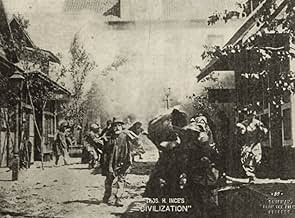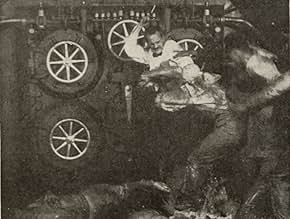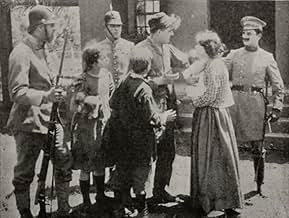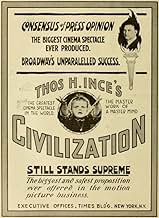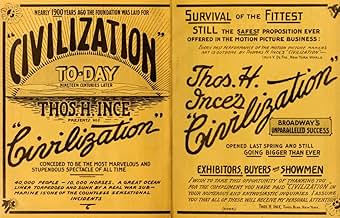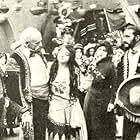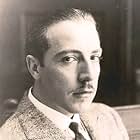Füge eine Handlung in deiner Sprache hinzuChrist takes on the form of a pacifist count to end a senseless war.Christ takes on the form of a pacifist count to end a senseless war.Christ takes on the form of a pacifist count to end a senseless war.
- Regie
- Drehbuch
- Hauptbesetzung
- Auszeichnungen
- 1 wins total
Howard Hickman
- Count Ferdinand
- (as Howard C. Hickman)
Virginia Getchell
- Little Girl
- (Nicht genannt)
John Gilbert
- Extra
- (Nicht genannt)
Alice Jorgens
- Girl
- (Nicht genannt)
Empfohlene Bewertungen
The inventor of a submarine of war finds his conscience troubled when called upon to sink a passenger ship suspected of transporting weapons for the enemy. The ill-fated Thomas H. ince's ambitious epic features some spectacular battle scenes, and is admirably compact despite its scale (if it were made by Griffith it would probably have been at least an hour longer) but is far too preachy and simplistic for a modern audience. Must have packed quite a punch back in 1915, though.
Believe it or not this movie was supposed to keep America out of WW1. Bankrolled by a pacifist organisation this movie was produced and at least partially directed by Thomas Ince, who is famous for producing many of William S. Hart's westerns. The king of a small European country declares war on a neighbouring land. The fact that the agressors dress like the Kaiser's German troops was lost on no one back then I am sure. Count Ferdinand invents a new type of submarine which is used to destroy ships carrying arms and supplies to enemy soldiers. He refuses to fire on lifeboats carrying innocent passengers though and sinks his own sub. This is where things go slightly out of hand. Sent to the Underworld (where the dead souls are all nude, regrettably they are also all male) he meets Jesus himself who decides the time is right to return to Earth to remind people to live in peace. Taking over Count Ferdinand's body the poor guy is almost crucified a second time before showing the King the horrors of war that he has overlooked while being safe in his palace. Alas the message of this film did not reach audiences the way it was supposed to; a year later America entered the war anyway. Many young men learned the hard way that the terrors depicted in the movie were right on the money. D.W. Griffith made an anti-war film called HEARTS OF THE WORLD but it was in release for only about 2 months when the war ended. Cecil B. DeMille got into the act too when he cast Mary Pickford as THE LITTLE AMERICAN in 1921. Thomas Ince wisely went back to doing westerns. If you want to see a silent film with a really effective anti-war message check out King Vidor's THE BIG PARADE (1924).
The movie is generally pretty silly, even by silent film standards. Still, the first half of the picture has some good scenes -- especially the "moment of truth" aboard the submarine. Unfortunately, once the Count goes to the underworld the film goes with him!
Producer Thomas Ince was inspired by President Woodrow Wilson pledge to "keep us out of war" during the first couple of years of World War One when he accepted Charles Sullivan's script on universal peace. Ince directed Sullivan's screenplay into one of cinema's first antiwar films, June 1916's "Civilization."
The bare outline of the high-budgeted and sprawling movie focuses in on a German submarine commander who refuses to sink a liner carrying both civilian passengers and munitions despite orders to do so. The Count gets a quick trip to heaven after he blew up his sub, where Jesus sends him back to earth with a message to change the king and his countrymen's mind to stop the war and spread peace throughout the world.
A spokesman for the Democratic National Committee claims "Civilization" was a huge asset to Wilson's re-election victory over Republican Charles Hughes in the fall of 1916 on the incumbent's anti-war platform. Because of the film's successful and popular showing, "Civilization" is seen as the first movie to influence voters in a presidential election.
Ince, ever the publicity seeker, paid actress Billy Burke, who was just beginning in film, to pretend to faint in the audience during "Civilization's" showing in a major city's theater. A husband whose wife died as an extra during the movie's production, and who didn't have a photograph of her, was reportedly attending every showing of "Civilization" to see his late wife on the screen. He must have been disappointed when the movie was withdrawn from public viewing as soon as Wilson and Congress had declared war on Germany and its allies the following April 1917.
Another lasting effect "Civilization" had was on young Yasujiro Ozu, who was drawn to its story and its cinematography, and encouraged him to be involved in movies. Ozu would become one of Japan's most heralded directors in the 1950's, with his "Tokyo Story" voted in some polls as the greatest movie ever made.
A spokesman for the Democratic National Committee claims "Civilization" was a huge asset to Wilson's re-election victory over Republican Charles Hughes in the fall of 1916 on the incumbent's anti-war platform. Because of the film's successful and popular showing, "Civilization" is seen as the first movie to influence voters in a presidential election.
Ince, ever the publicity seeker, paid actress Billy Burke, who was just beginning in film, to pretend to faint in the audience during "Civilization's" showing in a major city's theater. A husband whose wife died as an extra during the movie's production, and who didn't have a photograph of her, was reportedly attending every showing of "Civilization" to see his late wife on the screen. He must have been disappointed when the movie was withdrawn from public viewing as soon as Wilson and Congress had declared war on Germany and its allies the following April 1917.
Another lasting effect "Civilization" had was on young Yasujiro Ozu, who was drawn to its story and its cinematography, and encouraged him to be involved in movies. Ozu would become one of Japan's most heralded directors in the 1950's, with his "Tokyo Story" voted in some polls as the greatest movie ever made.
WUSSTEST DU SCHON:
- WissenswertesInspired Yasujiro Ozu to become a film director.
- VerbindungenFeatured in The Moving Picture Boys in the Great War (1975)
Top-Auswahl
Melde dich zum Bewerten an und greife auf die Watchlist für personalisierte Empfehlungen zu.
Details
- Laufzeit1 Stunde 25 Minuten
- Farbe
- Sound-Mix
- Seitenverhältnis
- 1.33 : 1
Zu dieser Seite beitragen
Bearbeitung vorschlagen oder fehlenden Inhalt hinzufügen


